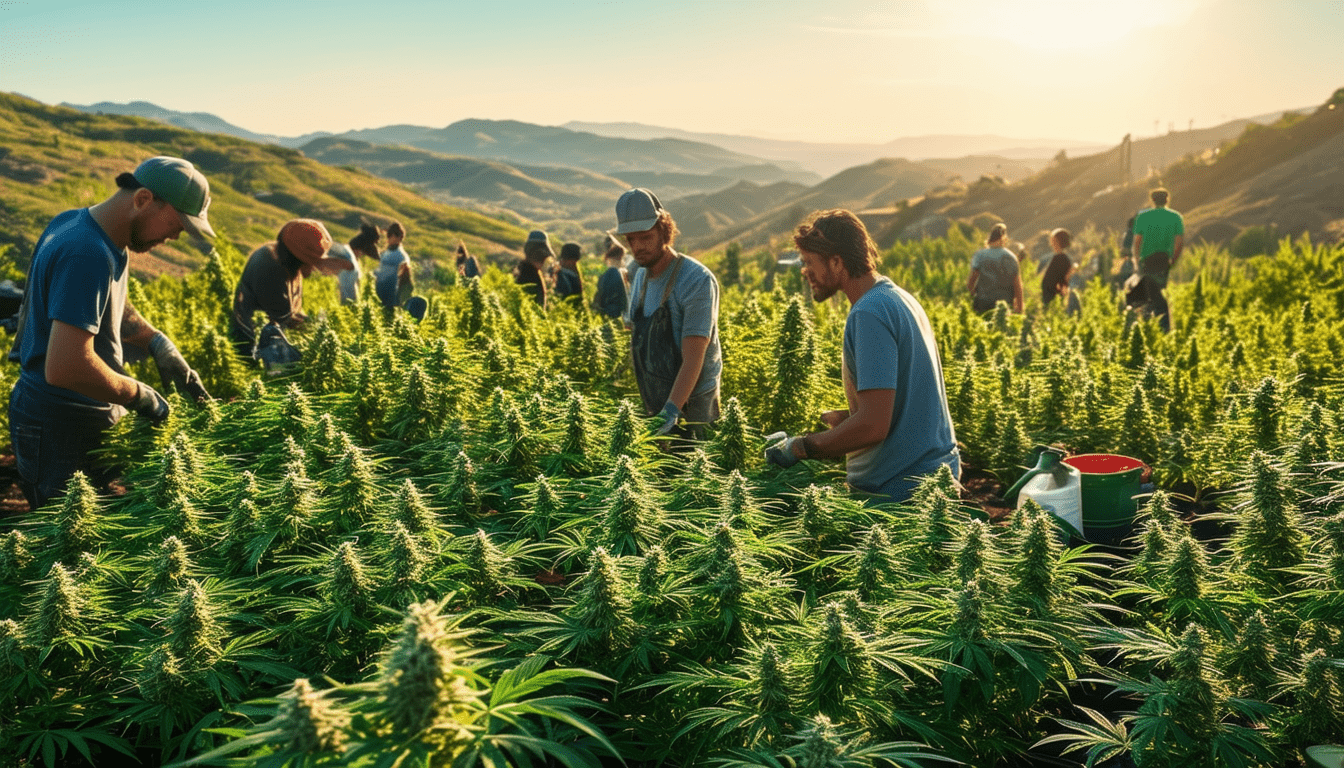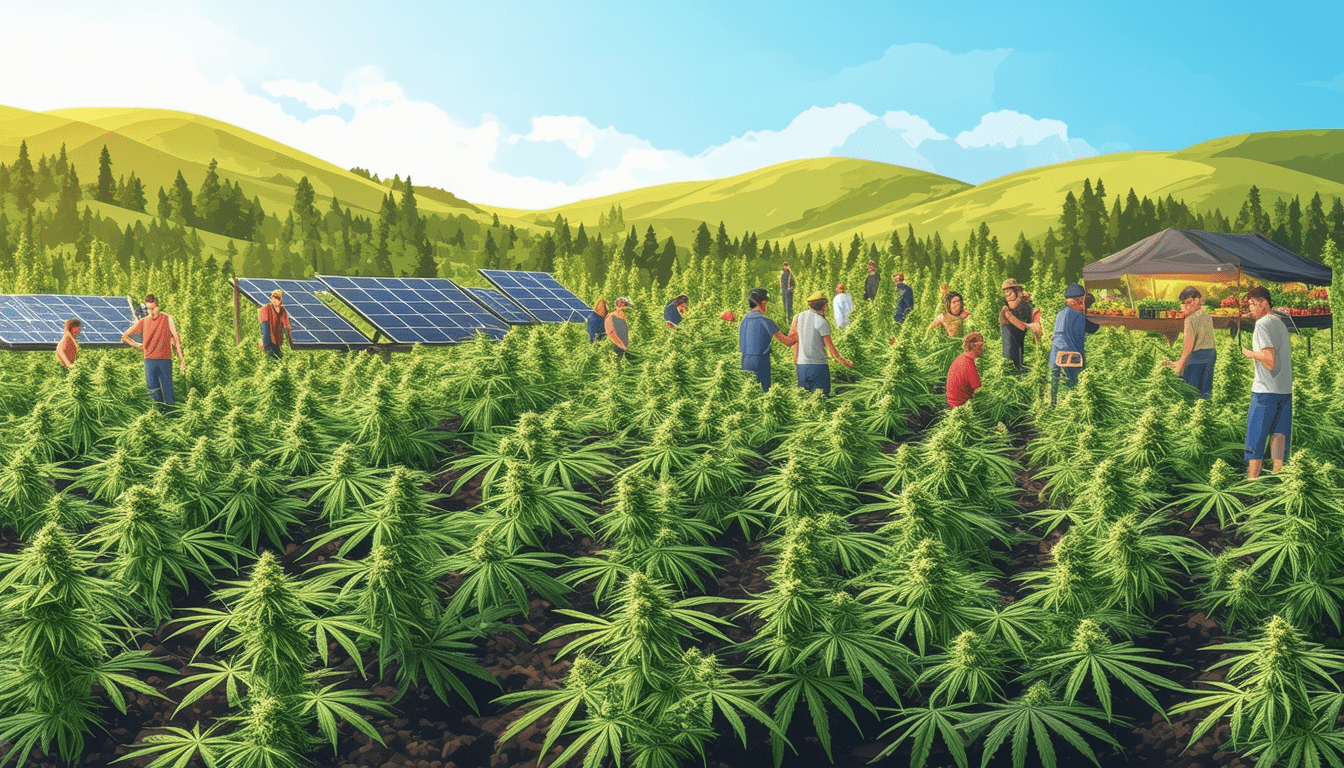Exploring the benefits of outdoor cannabis cultivation
|
IN BRIEF
|
Outdoor cannabis cultivation is gaining attention for its numerous advantages over indoor growing. As the industry evolves, the benefits of harnessing natural sunlight and leveraging ecological practices become increasingly clear. Cultivating cannabis outdoors allows for larger plants with larger yields, reduced production costs, and improved terpene development that can enhance the flavor and efficacy of the final product. Additionally, outdoor growing aligns with sustainable practices, thereby benefiting both the environment and the economy.

Outdoor cannabis cultivation is gaining popularity due to its numerous ecological and economic advantages. By harnessing the sun’s energy, growers can achieve higher yields, lower costs, and enhance the overall quality of the cannabis produced. This article delves into the various benefits of cultivating cannabis outdoors, making a compelling case for why this practice should be prioritized.
Natural Sunlight: A Powerful Resource
One of the most significant benefits of outdoor cannabis cultivation is the exposure to natural sunlight. Unlike indoor setups which rely on artificial grow lights, outdoor plants can bask in the sun throughout the day. This not only promotes healthy growth but also stimulates the development of diverse terpenes that contribute to the healing properties and flavor profiles of the cannabis. According to studies, buds grown outdoors tend to mature into richer and more potent products.
Lower Production Costs
Outdoor cultivation typically comes with a lower production cost compared to indoor setups. The initial investment in infrastructure and equipment for indoor growing can be substantial, often necessitating complex systems for lighting, ventilation, and climate control. In contrast, outdoor growers primarily rely on natural elements, significantly reducing energy consumption and associated costs. This economical approach allows cultivators to invest in other essential areas such as soil quality and organic practices.
Healthier Plants and Larger Yields
When cannabis plants are allowed to grow outdoors, they benefit from increased space and a natural ecosystem. As outdoor plants spread their roots and canopies, they often achieve larger sizes and, consequently, produce larger yields than their indoor counterparts. This spatial advantage leads to better nutrient absorption and a more robust overall plant health, further enhancing the quality of the final product.
Microbial Biodiversity
Outdoor cultivation also promotes microbial biodiversity within the soil. A rich microbial environment can enhance soil health, increasing the availability of essential nutrients that cannabis plants need to thrive. Healthy soil teeming with beneficial microorganisms contributes to better disease resistance and allows for a more sustainable growing practice. This natural interaction between the plants and their environment fosters both ecological balance and outstanding cannabis quality.
Environmental Sustainability
Just as important are the environmental benefits provided by outdoor cannabis cultivation. By utilizing sunlight and avoiding high energy costs, this method significantly reduces the carbon footprint associated with cannabis production. Furthermore, cultivation can promote biodiversity in agricultural spaces, improve soil conditions, and contribute to carbon sequestration efforts. Studies have shown that sustainable practices in cannabis growing can yield positive outcomes for both the planet and local ecosystems.
Community Impact and Economic Viability
Investing in outdoor cannabis cultivation can also result in considerable economic benefits for local communities. By shifting focus from indoor to outdoor practices, growers can create job opportunities in agriculture and stimulate local economies. Additionally, as consumers become more aware of the ecological impact of their choices, demand for sustainably grown cannabis products is likely to rise, benefiting those who adopt outdoor cultivation methods.
Conclusion: The Future of Cannabis Cultivation
With numerous advantages ranging from cost savings and healthier plants to significant environmental impact, outdoor cannabis cultivation stands out as a viable method for the future. Embracing this approach not only benefits growers through increased yields and reduced costs but equally supports environmental sustainability and community growth.
For more information about cannabis cultivation techniques, check out resources like this guide and dive deeper into the therapeutic potentials of cannabis through studies available here.
Comparison of Outdoor Cannabis Cultivation Benefits
| Benefit | Description |
| Natural Sunlight | Utilizes solar energy, leading to healthier plant growth and reduced energy costs. |
| Larger Yields | Outdoor plants can grow larger, often producing higher yields compared to indoor cultivation. |
| Cost-Effectiveness | Less investment in infrastructure and equipment, leading to lower production costs. |
| Microbial Biodiversity | Enhanced soil health from a diverse ecosystem, improving plant resilience. |
| Terpene Development | Buds grown outdoors develop unique terpenes that enhance flavor and aroma. |
| Pest Natural Management | Outdoor environments can support natural predators to help manage pests, reducing chemical use. |
| Extended Growing Season | In some regions, outdoor cultivation allows for multiple harvests in a single growing season. |

Outdoor cannabis cultivation presents a myriad of advantages that resonate with sustainability and economic viability. Unlike indoor operations that rely heavily on artificial lighting and expensive equipment, growing cannabis outdoors allows cultivators to take advantage of the sun’s natural power. This method not only promotes environmental well-being but also enhances crop yield and quality, making it a compelling choice for cannabis cultivators.
Harnessing Natural Light
The most significant benefit of outdoor cultivation is the exposure to natural sunlight. Sunlight enables cannabis plants to thrive, leading to robust growth cycles that can yield plants of considerable size. Each outdoor plant has ample space to spread its roots and canopy, allowing them to absorb essential nutrients and moisture from the soil more efficiently than their indoor counterparts. This natural growth cycle results in larger plants, often producing larger and more fragrant buds.
Cost-Effectiveness
When considering the overall costs associated with cannabis cultivation, outdoor operations tend to be more cost-effective than indoor setups. Outdoor growers require significantly less infrastructure, energy, and equipment to maintain their operations. Without the need for expensive grow lights or complex HVAC systems, cultivators can invest in their crops and expand their fields, rather than spending on operational overhead.
Environmental Benefits
Outdoor cannabis cultivation is inherently more sustainable. It leverages microbial biodiversity found in natural ecosystems, which supports healthier soil and fosters natural pest control. Methods such as regenerative farming practices improve the land’s health over time, enhancing carbon sequestration and promoting biodiversity. This makes outdoor cultivation not only a better choice for growers but also beneficial for the planet, aligning with eco-friendly practices within the cannabis industry. More details on sustainability can be found here.
Enhanced Terpene Development
Growing cannabis outdoors provides an environment that fosters the development of various terpenes which contribute to the plant’s unique aroma and flavor profiles. Many terpenes flourish under natural light and in diverse outdoor conditions, adding depth to the final product. This differentiation enhances the appeal of outdoor cannabis among consumers seeking distinctive flavors and aromas. Moreover, outdoor cultivation typically results in cannabis strains that exhibit a more nuanced chemical profile, making them particularly interesting for both recreational and medicinal users.
Higher Yields
Outdoor cannabis plants can often yield a significantly higher quantity of product per plant compared to indoor counterparts. With the right conditions, growers can achieve up to four harvests per year in some regions, which is a phenomenal advantage for maximizing revenue. This increased productivity stems from the optimal growing conditions that outdoor cultivation provides, combining sunlight, space, and natural nutrients that are often difficult to replicate indoors.
Nurturing Ecosystem Support
Lastly, outdoor cultivation encourages a balanced ecosystem around the cultivation area. By using organic farming practices, growers promote healthy habitats for bees and other pollinators. This biodiversity supports not only cannabis plants but also surrounding crops, aiding in agricultural productivity and resilience against pests. The intertwining of outdoor cannabis cultivation with local ecosystems demonstrates a forward-thinking approach to farming that can have lasting positive impacts on the environment.
- Natural Light: Utilizes the sun for optimal growth.
- Cost-Effectiveness: Lower production and energy costs.
- Larger Yields: Bigger plants lead to more substantial harvests.
- Terpene Development: Enhanced flavor profiles from natural conditions.
- Microbial Biodiversity: Healthier soil ecosystem contributes to plant health.
- Less Infrastructure Required: Reduces reliance on artificial grow setups.
- Environmental Sustainability: Lowers carbon footprint of cultivation.
- Seasonal Variety: Opportunity for multiple harvests per year in favorable climates.

Outdoor cannabis cultivation has gained significant attention due to its numerous advantages over indoor growing methods. By harnessing the power of natural sunlight and promoting biodiversity, growers can achieve larger yields and lower production costs. This article delves into the ecological and economic benefits of cultivating cannabis outdoors, providing insight into why this method is an increasingly popular choice among growers.
Harnessing Natural Light
One of the primary benefits of outdoor cannabis cultivation is the access to uninterrupted sunlight. Unlike indoor grow operations that rely on artificial lights, outdoor plants benefit from the full spectrum of natural sunlight. This natural light not only enhances the overall growth of the plants but also contributes to the production of vital terpenes and cannabinoids. Plants grown under the sun can develop unique flavor profiles and therapeutic compounds that are often absent in indoor-grown cannabis.
Cost-Effectiveness of Outdoor Cultivation
Cost is a crucial factor in cannabis cultivation, and outdoor growing proves to be a more economically viable option. The initial investment for outdoor farming is significantly lower than indoor setups, which require extensive infrastructure, including grow lights, climate control systems, and ventilation. Outdoor growers can save on electricity bills and reduce equipment maintenance costs while still achieving high yields.
Space and Plant Growth
Another advantage of outdoor cultivation is the abundant space available for plants to spread their roots and canopies. Outdoor-grown cannabis can grow much larger than those confined indoors, resulting in a more robust plant and, consequently, larger harvests. This additional space is beneficial for root development, which is crucial for nutrient absorption and overall plant health.
Environmental Sustainability
Outdoor cultivation aligns with sustainability practices, making it an attractive option for environmentally conscious growers. By utilizing natural processes, outdoor farming minimizes the carbon footprint linked to artificial light use and extensive energy consumption typical of indoor cultivation. Furthermore, outdoor cannabis farming encourages biodiversity, as it promotes interactions between plants and local wildlife, fostering a balanced ecosystem.
Natural Pest Control
While indoor growers often face pest management challenges, outdoor cultivation can naturally mitigate these risks. With the presence of beneficial insects and animals, outdoor gardens can ensure better pest control without the need for harmful chemicals. This not only enhances the health of the cannabis plants but also contributes to a healthier environment overall.
Enhanced Terpene Development
Outdoor cannabis plants often exhibit superior terpene development compared to their indoor counterparts. The diverse environmental conditions outdoors, including variations in temperature and humidity, stimulate the production of a wider range of terpenes. These aromatic compounds are not only essential for the flavor and scent of cannabis but also play a significant role in enhancing its therapeutic effects.
Emphasizing the myriad benefits of outdoor cannabis cultivation demonstrates how this method can be both ecologically responsible and economically sound. From harnessing natural light to reducing costs and enhancing plant size and yields, outdoor cultivation represents a sustainable approach to cannabis growth that supports both growers and the environment.


Post Comment